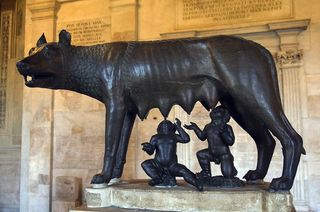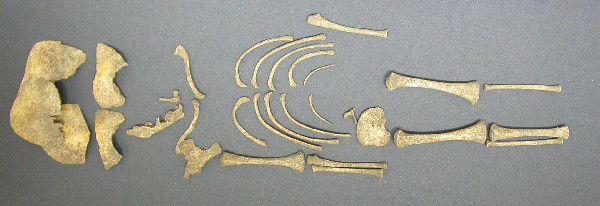Did the Roman Empire Kill Babies Around 0ad
Aboriginal Roman Infanticide Didn't Spare Either Sex activity, DNA Suggests

A new expect at a enshroud of infant bones discovered in Uk is altering assumptions well-nigh why ancient Romans committed infanticide.
Infant girls were obviously not killed more oftentimes than baby boys, researchers report in an upcoming outcome of the Journal of Archaeological Science.
"Very often, societies accept preferred male person offspring, then when they practice infanticide, information technology tends to be the male babies that are kept, and the female person babies that are killed," said study researcher Simon Mays, a skeletal biologist for English Heritage, a non-governmental organization that protects historic sites.
Though aboriginal Romans indeed preferred boys, there is no evidence they went as far as infanticide to skew the sexual activity ratio, Mays told LiveScience. [The Science of Death: ten Tales from the Crypt]
Tiny skeletons
Mays and his colleagues used a technique called ancient DNA assay to study infant bones constitute at a site called Yewden Villa, near Hambleden, in England. Although the site was beginning excavated in 1912, and constitute to hold the remains of infants dating back about 1,800 years, the baby bones were since thought to take been lost, Mays said.

But recently, nearly a century after the initial excavation, archaeologist Jill Eyers, director of Chiltern Archaeology in England, constitute the bones tucked away in tiny boxes in the site archive.
In 2011, Mays and Eyers published a report of the bones suggesting the babies were victims of infanticide, based on the fact that measurements of the long bones of the arms and legs suggested that all of the babies died at the same age, right at the time of birth.
If the deaths had been natural, Mays said, you'd expect to encounter some premature babies, some who died around the time of birth, and others who died in the weeks afterwards birth.
Because of the loftier number of skeletons, the researchers speculated the site contained a brothel, and the babies were those of prostitutes. Simply that thought was always "a long shot," Mays said.
In the new study, the researchers delved into why these babies were killed. Ancient Roman texts refer to infanticide equally an accepted practice, and the only mode people could control the size of their families in a time earlier reliable contraception. (In fact, Rome'due south foundation myth involves twin boys, Romulus and Remus, who are left to die by their mother, but are saved by wild animals.)
The texts refer to infanticide in Rome itself, withal, which had a different civilisation than its far-flung territories, such every bit those in Uk, Mays said.
And although the Roman preference for boys would suggest that Romans adept sex activity-selective infanticide, Mays said, at that place is simply one document to back up that assumption — a letter of the alphabet from one Roman soldier stationed in England to his pregnant wife, telling her not to carp keeping the baby if information technology's a girl when information technology'south built-in.
Deoxyribonucleic acid testing
It'southward impossible to tell the sex of a baby past looking at the shape of the bones. Sex differences simply sally subsequently puberty, Mays said. So the researchers turned to a newer tool: aboriginal Deoxyribonucleic acid assay. They tested 33 of the 35 most consummate remains, merely because DNA does not preserve well in old basic, the researchers were able to tease out sequences for simply 12 of the 33.
Of those, seven were female and 5 were male, a relatively even sex activity ratio, Mays said.
What'south more, none of the babies shared a female parent, a strike confronting the brothel hypothesis. If the babies were the offspring of prostitutes, Mays said, the women would likely accept been pregnant once more and once again.
The 12 babies studied in the new paper bring the total number of ancient Roman babies idea to be victims of infanticide who have undergone Deoxyribonucleic acid testing to 25. Overall, there is no evidence that baby girls were killed more ofttimes.
"It seems every bit though they weren't using infanticide to manipulate the sexual practice ratio," Mays said.
"Now that we tin utilise Dna to tell whether the babies were male or female, nosotros're starting to revise the commonly held assumptions well-nigh infanticide in the Roman world," said Kristina Killgrove, a bioarchaeologist at the University of Due west Florida, who was not involved in the research.
Equally horrifying equally the killing of newborns seems to modern people, in aboriginal Rome, babies weren't considered fully human upon birth, Mays said. Instead, they gained humanity over fourth dimension, first with their naming a few days afterwards nativity, and later when they cut teeth and could consume solid nutrient.
Follow Stephanie Pappas on Twitter and Google+ . Follow us @livescience , Facebook & Google+ . Original article on LiveScience.
Source: https://www.livescience.com/42834-ancient-roman-infanticide.html

0 Response to "Did the Roman Empire Kill Babies Around 0ad"
Post a Comment